Apple iPad mini with Retina Display: Reviewed
by Anand Lal Shimpi on November 16, 2013 8:00 AM ESTThe Display
The big story behind the new iPad mini is of course its 7.85-inch Retina Display. We’re talking about the same 2048 x 1536 resolution as the iPad Air, but in a much smaller form factor. The result is the highest pixel density of any Apple display ships today, tying with the iPhone 5S. The impact on the overall experience is pretty significant. Text is obviously a lot sharper, but even graphics are a lot nicer to look at on the new Retina Display. The gains aren't quite as obvious as they were on the larger iPad, but after living with the Retina mini for a while I can't easily go back to the previous version.

iPad mini (left) vs. iPad mini with Retina Display (right)
I ran Marco Arment's image retention test on the Retina mini and didn't see even the slightest degree of image retention. My old, non-Retina iPad mini on the other hand exhibited image retention. I suspect Apple is multi-sourcing its displays here, which could obviously contribute to varied behavior. At least on the two minis I have, image retention isn't an issue.
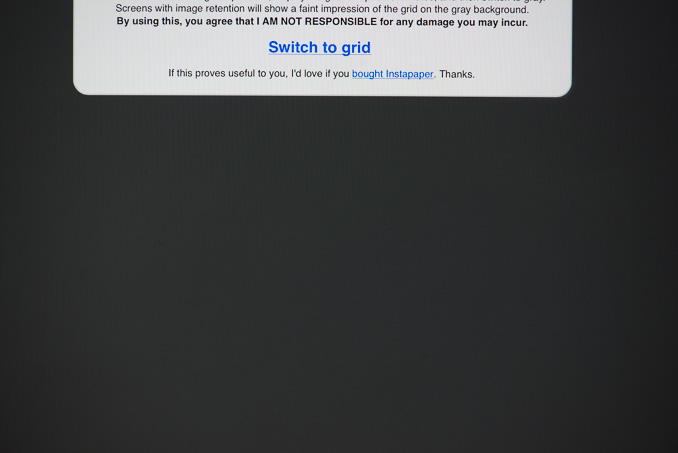
In the conclusion of my iPad Air review I wrote about the new mini as finally being a no-compromises smaller iPad. Much like my assertions last year of a Retina mini not being in the cards, it turns out that I was wrong on this point as well. Although display resolution is no longer a concern on the mini, color gamut hasn’t changed between the old and new minis. A quick look at our gamut test gives us an idea of what’s going on:

The iPad mini with Retina Display has the same color gamut as the standard iPad mini, which is narrower than the iPad Air and less than the sRGB coverage we normally look for. The biggest issue here is that there are other smaller tablets in this price range that do offer sRGB coverage (e.g. Nexus 7, Kindle Fire HDX 8.9).
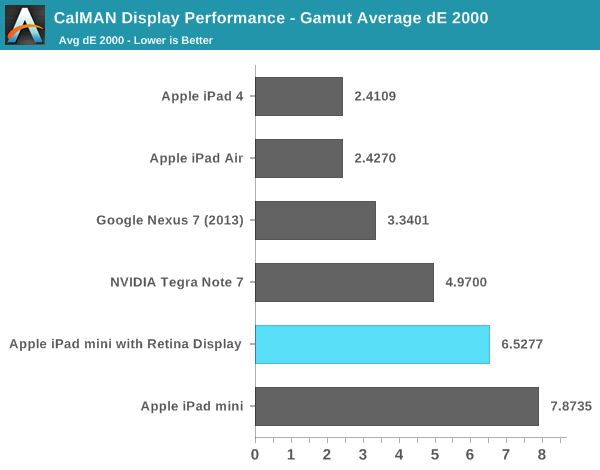
I suspect the justification here is Apple likely views the bigger iPad as being a better fit for photographers/those who care about color reproduction, but it’s a shame that this is a tradeoff that exists between the two iPads especially given how good Apple is about sRGB coverage in nearly all of its other displays.
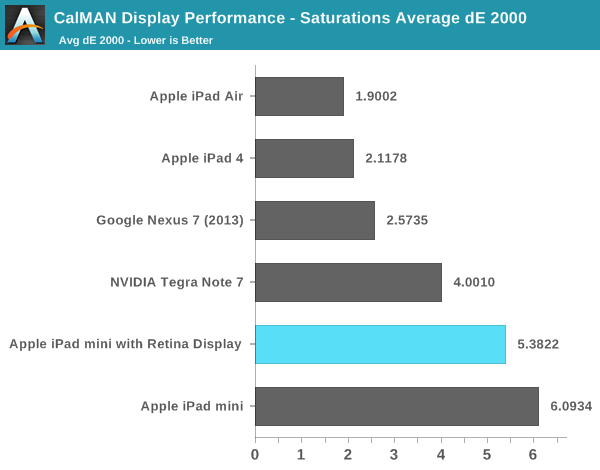

One of the simplest visual tests is to use one of iOS 7’s more colorful wallpapers and compare the Retina mini and iPad Air side by side:
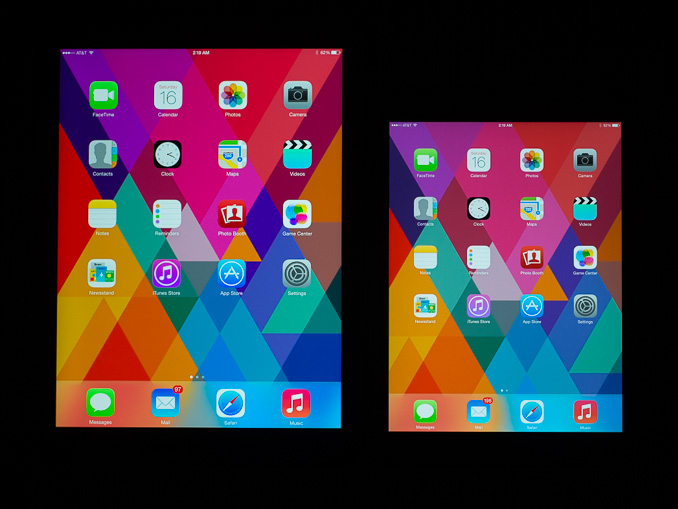
Pay attention to the color of the red triangles in the lower left
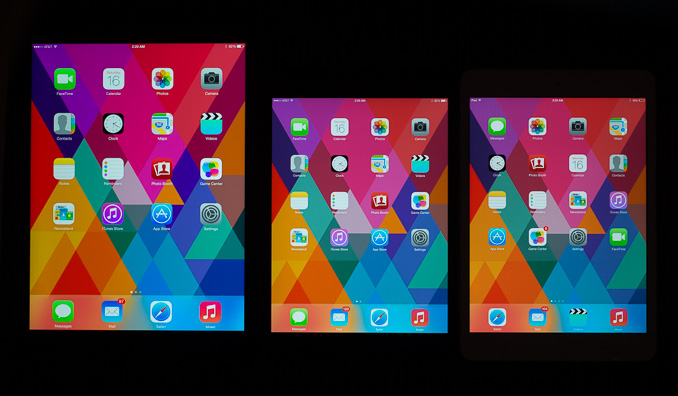
From left to right: iPad Air, iPad mini with Retina Display, iPad mini
The difference is small but apparent, particularly if you’re used to panels with full sRGB coverage like the iPad Air or any of the rMBPs/iMacs. The biggest deviations are in reds/blues and magenta in between as you can tell from the CIE chart above.

Within its gamut coverage, the mini’s panel is fairly accurate. A look at our GMB checker test shows performance competitive with the Nexus 7 and not far off the 4th generation iPad. Grayscale reproduction is also quite good. The display looks really good otherwise, but you don’t get the same visual punch you do on the iPad Air.
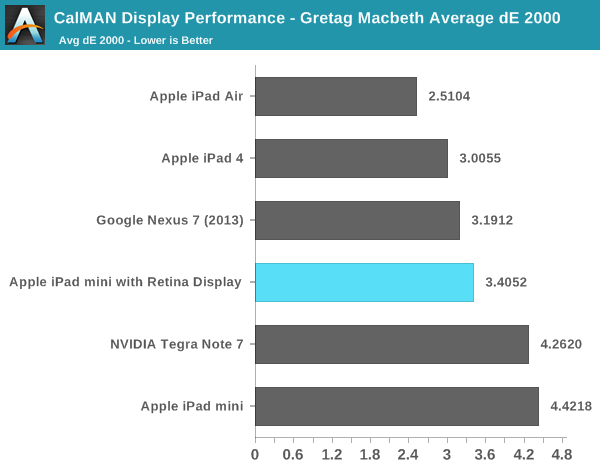

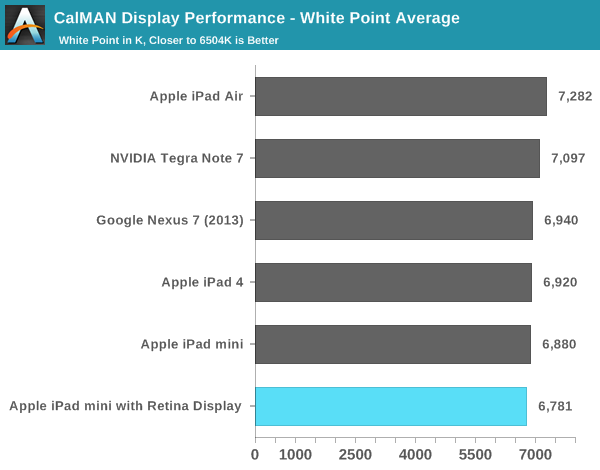
Compared to the previous generation mini we’re obviously talking about a much better panel. But for those of you on the fence between the mini and Air, the Air does still hold a display advantage.
Black levels are competitive and contrast ratio stays fixed at around 800:1 regardless of whether we’re talking about max brightness or the 200 nits we run all of our battery life tests at. Max brightness is down a bit compared to the iPad Air.
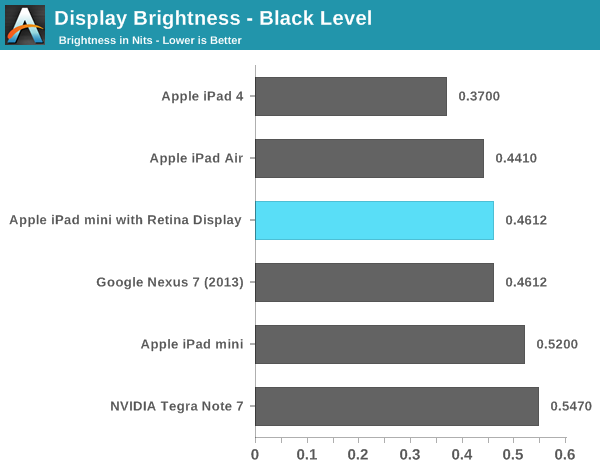
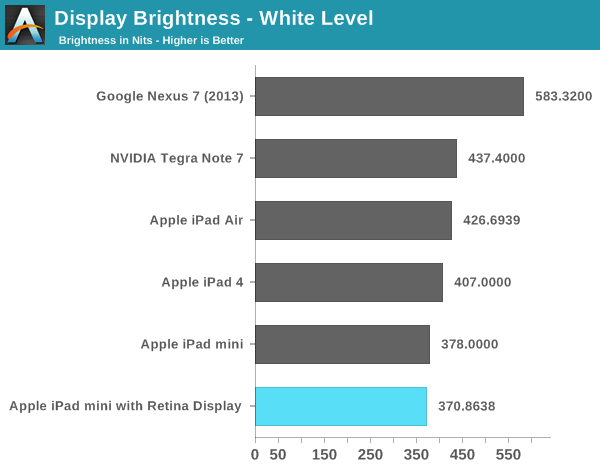
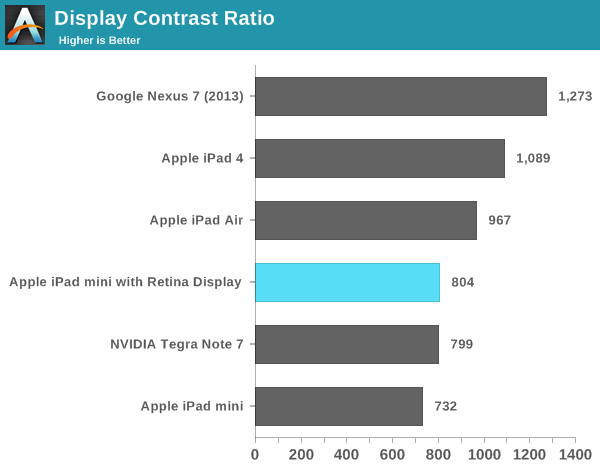










345 Comments
View All Comments
michal1980 - Saturday, November 16, 2013 - link
you must not have been here long enough. I'm still waiting for anand to change his name to appletigmd99 - Saturday, November 16, 2013 - link
Prove his bias.tigmd99 - Saturday, November 16, 2013 - link
What has he said about either OS that is not true?Puberticus - Saturday, November 16, 2013 - link
Seriously: if you don't like Apple gear and you weren't interested in a detailed review, why are you even commenting?pgari - Saturday, November 16, 2013 - link
I found Anand reviews a lot more unbiased (if any) than most of the people criticizing him: as a minimum he recognizes the weakness on Apple products as well the competitors' strengths, no as some people here who demonize Apple and reject all its products blindly.Disclaimer: My smartphone is a Nexus 5, my tablet a Venue 8 Pro and my laptop a MBA
tipoo - Saturday, November 16, 2013 - link
Shame about the inferior display gamut and slower soc. Makes the choice between it and Air a bit muddier. Funny how when the first display comparisons went around the apple faithful thought it was a hoax, lol.solipsism - Saturday, November 16, 2013 - link
For me it's not a deal breaker as I never use my iPad much. It's mostly for reading so I'm hoping the iPad Mini will be a better fit than the 10" variant.Overall that display is very impressive, but those displays on Amazon Kindle HGX and Nexus 7 are even more impressive when you consider their cost. Sure, they aren't profiting and use them to sell there other services unlike Apple who's model is to sell HW, but's still impressive. The only reason I haven't chosen them since I can read just fine on them is the awful 16:10 and 16:9, respectively, aspect ratio. 4:3 is considerably more ideal and I wish others would follow.
teiglin - Saturday, November 16, 2013 - link
Both of the Kindle Fire HDXs and the Nexus 7 are 16:10 (1920x1200 on the 7"-ers, and 2560x1600 on the HDX 8.9). Also the phrase "considerably more ideal" makes my brain hurt. As Brian once said, the battle for 4:3 is over and lost outside the iPad space (and LG phablets -_-)--even the iPhone gave up that ghost. I do miss 4:3 on the desktop though.solipsism - Saturday, November 16, 2013 - link
1) The iPhone was never 4:3.2) "More ideal" is not the same as "ideal".
3) There is obsolescing of aspect ratios as much you want to believe there is such a thing. There is only aspect ratios that are utilized for specific purposes and on a tablet 16:9 or 16:10 is not good for reading text, but 4:3 is. 16:9 is *more ideal* than 4:3 for video since it's closer to the common widescreen formats but most users don't spend the majority of their time watching videos.
teiglin - Sunday, November 17, 2013 - link
1) You're right, old iPhones were 3:2, but the point is that it gave up the fight against widescreen, just like other market segments.2) And I still take semantic issue with the idea of comparative ideal-ness--something is ideal, or it isn't. Something can be better or worse for a particular purpose, or closer to the ideal, but not more or less ideal.
3) Either you're missing a "no" in your first sentence, or I'm very confused. Either way, aside from my semantic quibbles, I don't generally disagree with what you're saying--4:3 is generally better for interacting with text than 16:9/10. Nevertheless, the fact remains that 16:9 is the standard for the vast majority of displays sold today, no matter how much I miss my first desktop LCD with its 5:4 aspect ratio.
What I find interesting in the discussion of aspect ratio is the lack of actual measurements. I mean, people mostly compare 7" tablets to the iPad mini, but the iPad mini's display is actually the same width as the 8.9" Kindle Fire's display (give or take a few hundredths of an inch). So maybe that should be the point of comparison for how much text you can display?